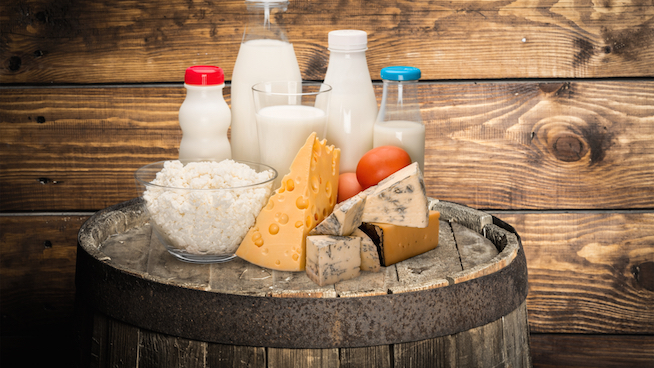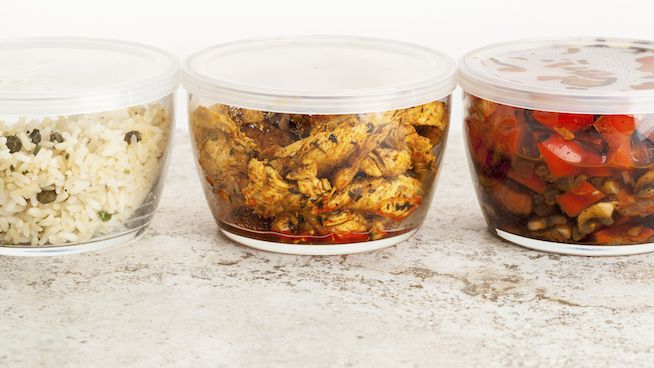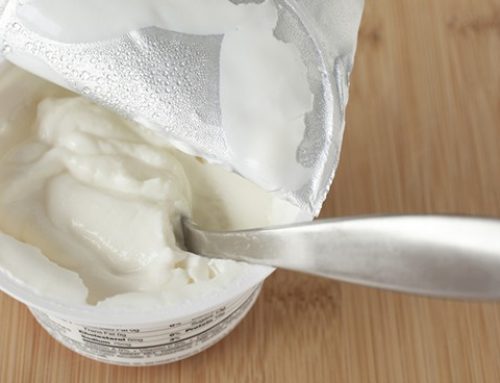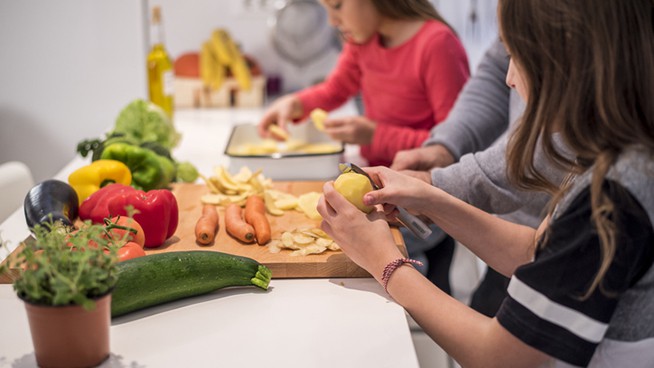Why Everything You Think You Know About Carbs Is Wrong
Here’s what you think you know about carbohydrates and the glycemic index (GI).
High-glycemic carbs (like white breads, white pastas, and sugary candy) go through your body and reach your muscles at a faster clip than low-glycemic carbs (like sweet potatoes, oatmeal, and brown rice).
The faster speed at which high-GI foods travel through your stomach and intestines, into your blood, and finally into your muscles is supposed to help quickly replenish the energy in your burnt-out biceps after a hard training session. This stops your body from breaking down hard-earned muscle for fuel.
Low-glycemic carbs, on the other hand, move more slowly through the body, so they aren’t capable of supplying that theoretical quick fix. But on the bright side, low-glycemic carbs won’t trigger a high insulin response, which is what makes you gain flab.
Because of all this, you’d think that you would want high-glycemic carbs immediately after a workout, so they can sail into your muscles as quickly as possible to prevent muscle breakdown. Low glycemic carbs, meanwhile, are your “everyday” carbs that you can consume (in moderation) without the fear of getting fat.
Right?
Not exactly. In fact, studies show this conventional wisdom is probably dead wrong.
A 2003 study performed at the University of Texas at Austin compared the rate sugars entered the blood in fit males (measured via tracer) in two cereals: Corn Flakes, a high-glycemic option, and All-Bran, which is low glycemic. The surprising result? “The rate of entry [of the sugar into blood] was identical,” says Anthony Almada, MSc and co-founder of the sports nutrition brand EAS.
The same study measured something that most people don’t think about but probably should: How fast the carbs actually reach your muscles. While carbs from the two cereals reached the blood at the same rate, get this— the low-GI all bran reached the muscles nearly twice as fast as the high-GI corn flakes. This means, counterintuitively, that low-GI food should be better at guarding against muscle breakdown following a vigorous workout. While it’s only been proven true in the case of corn flakes vs. bran cereal, it flies in the face of everything we thought we knew.
Rate Out, Not Rate In
To understand why the bran cereal reached muscles more quickly than the corn flakes, Almada likened the way the two cereals affect your body to a pair of bathtubs (tub A and tub B) being filled with water. For purposes of this example, your blood is the bathtub. The water from the faucets represents the speed at which sugar from corn flakes (tub A) and all-bran (tub B) reach it.
Both tubs pump water in at the same rate, but after a few minutes you notice that tub A is filling more rapidly than tub B. What gives? It turns out that tub A has a drain that’s half of the size of the drain in tub B.
The fuel (water, in this example) from both all-bran and corn flakes reaches the blood (the bathtub) at the same rate. But it drains into muscles (which is ultimately where you want it to go) at a faster rate when you eat the low-GI all-bran.
Why? When sugar enters the blood, it produces an insulin spike, which helps glucose (the fuel that powers your body) reach muscles. A higher insulin spike means a faster rate of muscle fueling. Whereas the conventional wisdom suggests that a high-GI food should cause a higher insulin spike than a low-GI food, in this case, the opposite was true.
“The all-bran cereal drained from the blood so quickly because it caused an insulin spike that was more than two times higher [than corn flakes],” says Almada.
Where Do You Go From Here?
Almada stresses that just because these particular foods reacted this way, it does not mean that other high-GI and low GI-foods will react similarly.
“[Those results are] unique to corn flakes and all bran,” Almada says. “You can’t extrapolate to any other foods.”
But the results of this study do tell us that just because a food is high glycemic doesn’t necessarily make it the best choice for post-workout refueling. In fact, the study’s findings call into question the entire notion of high-GI being fast and low-GI being slow.
The only way you’ll truly know the speed at which a sugar reaches your muscles is through a muscle biopsy, which is probably not something you’re going to do.
Instead of stocking up on post-workout carbs (to replenish the energy you burned during your workout) and protein supplements that may or may not work (to rebuild the muscles you broke down during your training session), Almada recommends “[choosing] foods that make you feel better and allow you to train harder the next day.” Just make sure you’re getting enough carbs to keep training hard.
At the end of the day, remember this: It’s not the foods you eat, when you eat them, or the gear you’re wearing that makes or breaks performance. “People forget that training is the most important thing for any athlete—not diet” Almada says, adding that another study compared the strength levels and physiques of two groups, one of which consumed whey protein post-workout and the other a McDonald’s Happy Meal.
“Both groups gained the same amount of muscle and lost the same amount of fat, same strength,” Almada says. “Diet is not some magical thing.”
Learn more on STACK’s Carbs page.
SOURCES
http://www.vivo.colostate.edu/hbooks/pathphys/endocrine/pancreas/insulin_phys.html
RECOMMENDED FOR YOU
MOST POPULAR
Why Everything You Think You Know About Carbs Is Wrong
Here’s what you think you know about carbohydrates and the glycemic index (GI).
High-glycemic carbs (like white breads, white pastas, and sugary candy) go through your body and reach your muscles at a faster clip than low-glycemic carbs (like sweet potatoes, oatmeal, and brown rice).
The faster speed at which high-GI foods travel through your stomach and intestines, into your blood, and finally into your muscles is supposed to help quickly replenish the energy in your burnt-out biceps after a hard training session. This stops your body from breaking down hard-earned muscle for fuel.
Low-glycemic carbs, on the other hand, move more slowly through the body, so they aren’t capable of supplying that theoretical quick fix. But on the bright side, low-glycemic carbs won’t trigger a high insulin response, which is what makes you gain flab.
Because of all this, you’d think that you would want high-glycemic carbs immediately after a workout, so they can sail into your muscles as quickly as possible to prevent muscle breakdown. Low glycemic carbs, meanwhile, are your “everyday” carbs that you can consume (in moderation) without the fear of getting fat.
Right?
Not exactly. In fact, studies show this conventional wisdom is probably dead wrong.
A 2003 study performed at the University of Texas at Austin compared the rate sugars entered the blood in fit males (measured via tracer) in two cereals: Corn Flakes, a high-glycemic option, and All-Bran, which is low glycemic. The surprising result? “The rate of entry [of the sugar into blood] was identical,” says Anthony Almada, MSc and co-founder of the sports nutrition brand EAS.
The same study measured something that most people don’t think about but probably should: How fast the carbs actually reach your muscles. While carbs from the two cereals reached the blood at the same rate, get this— the low-GI all bran reached the muscles nearly twice as fast as the high-GI corn flakes. This means, counterintuitively, that low-GI food should be better at guarding against muscle breakdown following a vigorous workout. While it’s only been proven true in the case of corn flakes vs. bran cereal, it flies in the face of everything we thought we knew.
Rate Out, Not Rate In
To understand why the bran cereal reached muscles more quickly than the corn flakes, Almada likened the way the two cereals affect your body to a pair of bathtubs (tub A and tub B) being filled with water. For purposes of this example, your blood is the bathtub. The water from the faucets represents the speed at which sugar from corn flakes (tub A) and all-bran (tub B) reach it.
Both tubs pump water in at the same rate, but after a few minutes you notice that tub A is filling more rapidly than tub B. What gives? It turns out that tub A has a drain that’s half of the size of the drain in tub B.
The fuel (water, in this example) from both all-bran and corn flakes reaches the blood (the bathtub) at the same rate. But it drains into muscles (which is ultimately where you want it to go) at a faster rate when you eat the low-GI all-bran.
Why? When sugar enters the blood, it produces an insulin spike, which helps glucose (the fuel that powers your body) reach muscles. A higher insulin spike means a faster rate of muscle fueling. Whereas the conventional wisdom suggests that a high-GI food should cause a higher insulin spike than a low-GI food, in this case, the opposite was true.
“The all-bran cereal drained from the blood so quickly because it caused an insulin spike that was more than two times higher [than corn flakes],” says Almada.
Where Do You Go From Here?
Almada stresses that just because these particular foods reacted this way, it does not mean that other high-GI and low GI-foods will react similarly.
“[Those results are] unique to corn flakes and all bran,” Almada says. “You can’t extrapolate to any other foods.”
But the results of this study do tell us that just because a food is high glycemic doesn’t necessarily make it the best choice for post-workout refueling. In fact, the study’s findings call into question the entire notion of high-GI being fast and low-GI being slow.
The only way you’ll truly know the speed at which a sugar reaches your muscles is through a muscle biopsy, which is probably not something you’re going to do.
Instead of stocking up on post-workout carbs (to replenish the energy you burned during your workout) and protein supplements that may or may not work (to rebuild the muscles you broke down during your training session), Almada recommends “[choosing] foods that make you feel better and allow you to train harder the next day.” Just make sure you’re getting enough carbs to keep training hard.
At the end of the day, remember this: It’s not the foods you eat, when you eat them, or the gear you’re wearing that makes or breaks performance. “People forget that training is the most important thing for any athlete—not diet” Almada says, adding that another study compared the strength levels and physiques of two groups, one of which consumed whey protein post-workout and the other a McDonald’s Happy Meal.
“Both groups gained the same amount of muscle and lost the same amount of fat, same strength,” Almada says. “Diet is not some magical thing.”
Learn more on STACK’s Carbs page.
SOURCES
http://www.vivo.colostate.edu/hbooks/pathphys/endocrine/pancreas/insulin_phys.html











